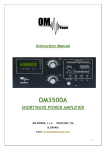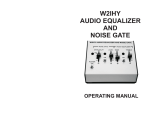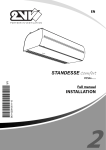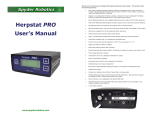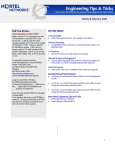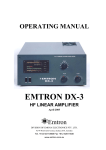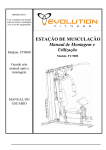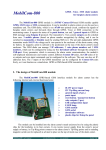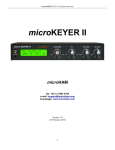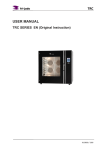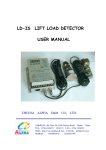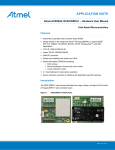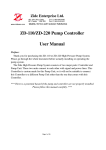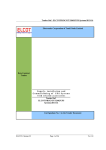Download OM 3500 HF
Transcript
Instruction Manual OM3500 HF SHORTWAVE POWER AMPLIFIER OM POWER, s. r. o. 930 30 Bác 126 SLOVAKIA Important safety instructions: • The amplifier contains high voltage circuits. Never turn the amplifier on without the upper lid in place. • The OM3500 HF amplifier is not to be used in a wet or humid environment nor to be exposed to rainfall. • The amplifier must be installed in such a way that free flow of hot air from the tube is allowed. The amplifier must not be installed in a constrained surrounding (i.e. tight shelves etc.) • During long operation the upper lid and the vent grid of the amplifier can reach high temperatures that can cause burn injuries. Do not touch these parts of the amplifier during operation. • The amplifier must be grounded during operation. • During operation the amplifier must be installed in such a way that the rear power supplies are accessible. • The amplifier can be operated only if both supply cables are connected. OM3500 HF reaches optimal parameters when it is connected to 2 phases. • Do not turn the amplifier on without having connected the antenna. A hazardous HF voltage may built up on the antenna connector after turning the amplifier on with no antenna connected. • Before opening the upper lid of the amplifier make sure that both power supplies have been disconnected for at least 5 minutes allowing the electrolytic capacitors to discharge fully. Never turn the amplifier on without the upper lid in place. • Make sure that all screws holding the case together are properly in place and tied before carrying the amplifier by the handles. • The amplifier is an A category product. In a household it can influence other electric appliances. In such cases the user is to take proper actions to mitigate this disturbance. General description of the OM 3500 HF Amplifier The linear amplifier OM 3500 HF is designed for all short wave amateur bands from 1.8 till 29 MHz (including WARC – bands ) and all modes . It is equipped with a ceramic tetrode GU78b. Specification of OM 3500 HF: Frequency coverage: Power output: amateur bands 1.8 – 29.7 MHz including WARC 3500 W in SSB and CW 3000 W in RTTY, AM and FM Drive Power: 60 to 80 W for full Output Power Input impedance: Output amplification: Output impedance: Maximum output SWR: SWR protection: or higher Intermodulation distortion : Suppression of harmonics: Tube: Cooler : Power supply : Transformers: Protection circuits: Bar graph indications: 50 Ohm VSWR < 1.5 : 1 17 dB 50 Ohm unbalanced 2:1 automatic switching to STBY , when reflected power is 350W 32 dB below nominal output < -50 dBc GU78b Ceramic tetrode Centrifugal blower + axial blower 2 x 230 V - 50 Hz one or two phases 2 pcs of toroidal transformer 2,5 kVA SWR too high Anode current too high screen current too high grid current too high Mistuning of power amplifier Soft start for protecting your fuses “switch –on blocking “ at opened amplifier - Power output – bargraph 50 LED reflected power – bargraph 20 LED current at screen ( Ig2 – bar graph 10 LED ) anode voltage, anode current, tuning – bargraph 30 LED LED indicators : current at control grid ( Igl – 2 LED ) WAIT – preheating of tube (180 sec ) STBY - standby OPR – operating condition FAULT – failure , switching off for abt. 4 sec Parameters: Weight: 485 x 200 x 455mm (width x height x depth) 43 kg General Description of OM3500 HF POWER AMPLIFIER HF PART In this amplifier a tetrode GU 78b is used in a grounded-cathode circuit (input into control grid). This amplifier achieves excellent linearity by the voltage stabilization of the control grid bias and the screen voltage. The power input is given to the control grid, using a broadband power transformer with an input impedance of 50 Ohms. This adaptable input circuitry ensures a good input SWR lower than 1.5:1 on all short-wave bands. The output of the amplifier is a Pi-L circuit. The ceramic capacitor for TUNE and LOAD are divided. This enables the amplifier to be tuned exactly and makes it possible to easily return to the previously set positions after band change. Top view on the opened OM3500 HF Tetrode GU78B Output Pi-L Circuit Output indicator Blower Tuning capacitor switch-on board Power supply board subpanel POWER SUPPLY Power supply of the amplifier is effected by two 2kVA toroidal transformers. A soft start is realized with the help of relays and resistors. The high anode voltage consists of 8 times 430V and 2A. Each of them has its own rectifier and filter. In the high voltage circuit safety resistors are employed to protect the amplifier against overload. The source for G2 is stabilized by a paralell stabilizator with BU508 transistors and delivers a voltage of 360V at 100mA. The -120V for the control grid is stabilized by means of zener diodes. SAFETY DEVICES Control and monitoring circuits ensure control and safety of the circuits of the device during malfunction of the PA. They are placed on the Control board, which is located on the subpanel. Putting the power amplifier into operation Coaxial cable The output of the transceiver is to be connected with the input of the amplifier via RG58 or similar cable. For the connection between the power amplifier and the antenna RG213 or similar coaxial cable suited for this high power is to be used. For INPUT and OUTPUT PL259-sockets with Teflon isolation are used. Mains plug1 Mains plug2 KEY OUT Fuses KEY IN OUTPUT INPUT Rear view of the amplifier Control cable With the control cable ensures switching from reception to transmission. The cable is shielded. On the side of the power amplifier a CINCH-socket is used. On the side of your transceiver you have to use a socket suitable for this transceiver. During transmitting the middle pin is connected to the ground. The relays of the OM3500 HF have to be switched earlier than HF is applied (cold switching). Modern transceivers have a time delay between PTT switching and power output. If you are using and older transceiver or transmitters without time delay we recommend to connect the PA in such a way that the transmit/ receive switch is connected with the KEY IN socket of the amplifier. The KEY OUT socket is to be connected with the PTT socket at the transceiver. The amplifier is equipped with two safety devices, which ensure that the Output relay is not switched under power mistakenly (hot switching). MAIN SUPPLY: The amplifier is connected to the mains with 2 cables with an EURO end. Each cable is to be switched to another phase of your main supply system! Both of them have to be able to deliver a power of 2.5 kVA ! If you use only one phase, you have to connect both cables to this one phase ! Your main supply has to be able to deliver 5 kVA on this one phase! In this case the power amplifier can’t deliver full output! ATTENTION: In each case the power amplifier has to be connected to your main supply system with the 2 cables! Normally the amplifier is used at 2 phases. If there is only one phase connect the 2 cables to this one! Grounding The amplifier has to be grounded properly! Connect the screw on the rear panel of the amplifier to your local grounding system with a copper-cable, use a cross-section of 4 mm2 at least. Connect your transceiver to the same grounding system of your shack carefully! If you use a power amplifier with higher output you have to be aware that your grounding system works properly. All parts have to be grounded to the same system. Use short cables and make sure that there are good contacts! Otherwise you run the risk of damaging your equipment, having problems with TVI/BCI or your signal may be distorted. Cooling The centrifugal blowers provide the necessary cooling of the amplifier, even during long contests. The main blower is activated by switching the PA on and it is turned off when aftercooling is finished (approx. 1-5 min after switching off the PA depending on the temperature of the tube). The supplemental fan is turned on depending on the temperature of the air exiting from the amplifier. It is switched on at 70°C and switched off at 60°C. Operation Operating elements (see photo of front panel) BAND - band selector switch (in MHz) TUNE - Anode capacitor for tuning, tuning of higher frequencies to "0", lower frequencies to „100“. LOAD - Output capacitor tunes antenna load resistance to amplifier. Capacity is low at „0“ and high at "100" on the scale. OFF - You switch off the amplifier by pressing this button. ON - You switch on the amplifier by pressing this button. Heating of tube is on and after 3min of delay the amplifier will be ready for operation. OPR/STBY - „OPERATE“ you will be ready for operation. At STBY, if WAIT-LED is on or the amplifier is off your transceiver is in bypass-mode directly connected to antenna. Maximum 200Watts ! 400Watts version is possible (FT9000). Please tell us at order ! RF OUTPUT - Bar graph – shows output power . REFLECTED POWER - Bar graph – shows reflected power of the antenna. 350W Ig2 HV/IP/TUNE maximum or amplifier switches to STANDBY-mode Bar graph – measerus the currency of the second grid in the range from -20mA to +80mA Bar graph – measure the anode voltage, anode currency or tuning of the amplifier TUNING The OM3500 HF amplifier is operated in class AB. Thus it’s possible to obtain a maximum output power at an excellent linearity. For this purpose the amplifier has to be tuned carefully. The operation of a mistuned PA will cause malfunctions, the increase of grid current (the GRID-MAX-LED will light up) and problems with TVI/BCI. The grid-current is shown with 2 LED diodes. It’s normal if the green LED is flashing or may be shining a little bit during peak operation. If you overload the amplifier the output power increases the grid current at very small rates and the red GRID-MAX-LED is shining and the safety devices the PA to STBY. If the red GRID-MAX-LED lights up with full intensity, you have overloaded the amplifier and must decrease the output. In SSB you will have a good output power if the green LED lights up a bit and the red LED is only flashing at the highest peaks of your voice. The current of screen grid is measured and shown in a Bar graph indicator. The amplifier has to be tuned in such a way that the current is between - 20 mA to +50 mA. At currents beyond these values the operating point will be shifted and IM-products will be generated. If a value of + 70mA is exceeded, the safety devices will switch the amplifier to STBY mode. Tuning instruction : Please note : Before starting tuning you have to check if the right antenna or a 50 Ohms load resistance is connected at the antenna output ! Switching on the amplifier: • • • put the switch at the multimeter to HV position put the OPR/STBY switch to STBY position press the „ON“ button The amplifier is prepared for operation with the following steps: • • • • the toroidal transformers are switched step by step. the blower of tube is switched on. the multimeter bargraph measures the high voltage; the normal value is 3.4 kV the WAIT LED lights up After switching on you have to check the functioning of the blower. Air must be blown out of the ventilating apertures above the tube. ( If there is any failure you have to press the „OFF”button immediately !) Heating the tube takes about 150 seconds. After this time the WAIT LED goes out and the amplifier is ready for operation. Tuning the amplifier to an output of 3500W 1. Switch BAND, TUNE and LOAD to the position according to the table: Band 1.8 3.5 7 10 14 18 21 24 28 Tune 54 56 44 80 62 75 40 60 32 Load 40 22 68 10 32 40 64 58 72 The tuning table available to you is made by using a dummy load! Each amplifier will have other values depending on used frequency and antenna! Make your own list for your own antennas! Use tuning position (see later)! 2. Reduce the power output of your transceiver to the 0. 3. Switch OPR/STBY to „OPR“ position (OPR LED lights up) 4. Choose TUNE position of multimeter. 5. Switch the PA to CW and increase output by 10W (OUTPUT PA abt. 500W) Please note! If the input power is higher than 15 W and the power amplifier is not correctly tuned, the safety devices will switch to STBY. After switching the amplifier to PTT, the amplifier will automatically reset and switch back to OPR mode after approximately 2 seconds. 6. Set TUNE in such a way, that the TUNE-LED lights up maximum left. 7. Set LOAD in such a way, that the TUNE LED on the TUNE scale lights up under the “V” sign. If it is possible to obtain the LOAD in 2 positions, set the position that is father to the right. 8. Repeat tuning several times according to 6 and 7. 9. Increase the input power until an output power of approximately 3500 W is reached. 10. Repeat steps 6 and 7 11. Set TUNE to maximum output power After this procedure the amplifier is tuned correctly and ready to give 3500W output power in all operation modes. At optimal tuning and full output power a positive 50mA current goes through the second grid. On 24 and 28 MHz bands optimal tuning can be achieved when one or two LEDs are lights up to the left from the position “V”. If less output is desired you can simply decrease the load of the transceiver. Please note: Should the amplifier demonstrate any malfunctions during tuning or should it not behave in accordance witch the description, interrupt the tuning procedure immediately and check the amplifier! Be sure to have not done any mistakes in choosing bands or TUNE/LOAD values! Be sure that SWR is not higher than 1:2 and input power is LOW! After cancelling human mistakes you will be able to work for long time with this amplifier! Indication of fault conditions OM3500 HF has the following indication LED on the front panel: GRID MIN GRID MAX HV IP FAULT OPR STBY WAIT - indication of first gird currency - max. First grid currency exceeded - measuring of anode voltage by bargraph - measuring of anode currency by bargraph - fault - amplifier in operation mode - amplifier in standby mode - heating of tube after switching on the amplifier Should a fault condition appear during the tuning or operation of the amplifier the safety circuits of OM3500 HF will react. The amplifier will be turned to STBY mode. After approx. 1 sec the control circuits will switch the amplifier back to OPR. If the fault will repeat 3 times after each other the control circuits will turn the amplifier to STBY. Brining the amplifier to OPR is enabled by using the OPR/STBY switch. After the reaction of safety circuits the FAULT LED will be lit up for approx. 5 sec depending on the nature of the fault. Flashing LED signalizes: IP HV FAULT GRID MAX GRID MAX + HV GRID MAX + IP HV + IP - anode currency exceeded - low anode voltage - reflected output exceeded - first grid currency exceeded - second grid currency exceeded - maximum load power exceeded - zero output power during tuning - tuning fault, incorrect tuning of the Pi-L output circuit In case your OM3500 HF amplifier is not working, please contact the manufacturer. IMPORTANT WARNING • • • • • • • • • The OM3500HF amplifier is not to be used in a wet or humid environment nor to be exposed to rainfall. The amplifier must be installed in such a way that free flow of hot air from the tube is allowed. The amplifier must not be installed in a constrained surrounding (i.e. tight shelves etc.) During long operation the upper lid and the vent grid of the amplifier can reach high temperatures that can cause burn injuries. Do not touch these parts of the amplifier during operation. The amplifier must be grounded during operation. During operation the amplifier must be installed in such a way that the rear power supplies are accessible. The amplifier can be operated only if both supply cables are connected. OM3500HF reaches optimal parameters when it is connected to 2 phases. Do not turn the amplifier on without having connected the antenna. A hazardous HF voltage may built up on the antenna connector after turning the amplifier on with no antenna connected. Before opening the upper lid of the amplifier make sure that both power supplies have been disconnected for at least 5 minutes allowing the electrolytic capacitors to discharge fully. Never turn the amplifier on without the upper lid in place. Make sure that all screws holding the case together are properly in place and tied before carrying the amplifier by the handles.













